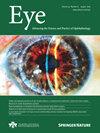Efficacy and safety of robotic Cyberknife radiotherapy in uveal melanoma: a systematic review and meta-analysis
IF 2.8
3区 医学
Q1 OPHTHALMOLOGY
引用次数: 0
Abstract
This systematic review is aimed to evaluate the efficacy and safety of robotic Cyberknife radiotherapy (CKRT) in the treatment of uveal melanoma (UM). Clinical studies published in English that assessed the efficacy and safety of robotic CKRT in UM were systematically searched in PubMed, Web of Science, Cochrane and Embase from inception to July 2023. Studies reporting extraocular tumours or other radiosurgery approaches were excluded. Outcomes measured were tumour size, reflectivity, local tumour control rate, eye retention rate, survival rate, complication rate, recurrence rate, and metastasis rate. Ten eligible articles involving 2370 patients with 2372 UMs were included in evidence synthesis. Meta-analysis showed 811 of 912 patients (0.89, 95% Cl: 0.86, 0.92) maintained local control for three years, and 1448 of 1724 patients (0.84, 95% Cl: 0.81, 0.88) preserved the eye in three years. During follow-up, 91% (0.91, 95% Cl: 0.85, 0.97) patients survived and 351 of 1720 patients (0.23, 95% Cl: 0.09, 0.37) involving 1722 eyes had tumour recurrence. In addition, 1376 patients (0.79, 95% Cl: 0.77, 0.82) preserved the eyeball in five years. Following treatment, approximately 20% of patients had radiation retinopathy (95% Cl: 0.13, 0.28), 19% developed glaucoma (95% Cl: 0.11, 0.28), and 22% experienced retinal detachment (95% Cl: 0.07, 0.36). CKRT is a viable, noninvasive RT for UM. The rate of local tumour control following treatment is comparable to that of other RT approaches, providing additional options based on the patient’s condition.

射波刀放射治疗葡萄膜黑色素瘤的疗效和安全性:系统综述和荟萃分析。
目的:本系统综述旨在评价机器人射波刀放疗(CKRT)治疗葡萄膜黑色素瘤(UM)的疗效和安全性。方法:系统检索PubMed、Web of Science、Cochrane和Embase从成立到2023年7月发表的评估机器人CKRT治疗UM疗效和安全性的英文临床研究。报告眼外肿瘤或其他放射手术入路的研究被排除。测量的结果包括肿瘤大小、反射率、局部肿瘤控制率、眼潴留率、生存率、并发症发生率、复发率和转移率。结果:10篇符合条件的文章纳入证据合成,涉及2370例患者,2372例UMs。meta分析显示,912例患者中有811例(0.89,95% Cl: 0.86, 0.92)保持局部控制3年,1724例患者中有1448例(0.84,95% Cl: 0.81, 0.88)保持眼睛3年。随访期间,91% (0.91,95% Cl: 0.85, 0.97)患者存活,1720例患者中有351例(0.23,95% Cl: 0.09, 0.37)患者1722只眼肿瘤复发。此外,1376例患者(0.79,95% Cl: 0.77, 0.82)在5年内保留了眼球。治疗后,大约20%的患者发生了放射性视网膜病变(95% Cl: 0.13, 0.28), 19%的患者发生了青光眼(95% Cl: 0.11, 0.28), 22%的患者发生了视网膜脱离(95% Cl: 0.07, 0.36)。结论:CKRT是治疗UM的一种可行的、无创的RT。治疗后的局部肿瘤控制率与其他RT方法相当,根据患者的病情提供了额外的选择。
本文章由计算机程序翻译,如有差异,请以英文原文为准。
求助全文
约1分钟内获得全文
求助全文
来源期刊

Eye
医学-眼科学
CiteScore
6.40
自引率
5.10%
发文量
481
审稿时长
3-6 weeks
期刊介绍:
Eye seeks to provide the international practising ophthalmologist with high quality articles, of academic rigour, on the latest global clinical and laboratory based research. Its core aim is to advance the science and practice of ophthalmology with the latest clinical- and scientific-based research. Whilst principally aimed at the practising clinician, the journal contains material of interest to a wider readership including optometrists, orthoptists, other health care professionals and research workers in all aspects of the field of visual science worldwide. Eye is the official journal of The Royal College of Ophthalmologists.
Eye encourages the submission of original articles covering all aspects of ophthalmology including: external eye disease; oculo-plastic surgery; orbital and lacrimal disease; ocular surface and corneal disorders; paediatric ophthalmology and strabismus; glaucoma; medical and surgical retina; neuro-ophthalmology; cataract and refractive surgery; ocular oncology; ophthalmic pathology; ophthalmic genetics.
 求助内容:
求助内容: 应助结果提醒方式:
应助结果提醒方式:


